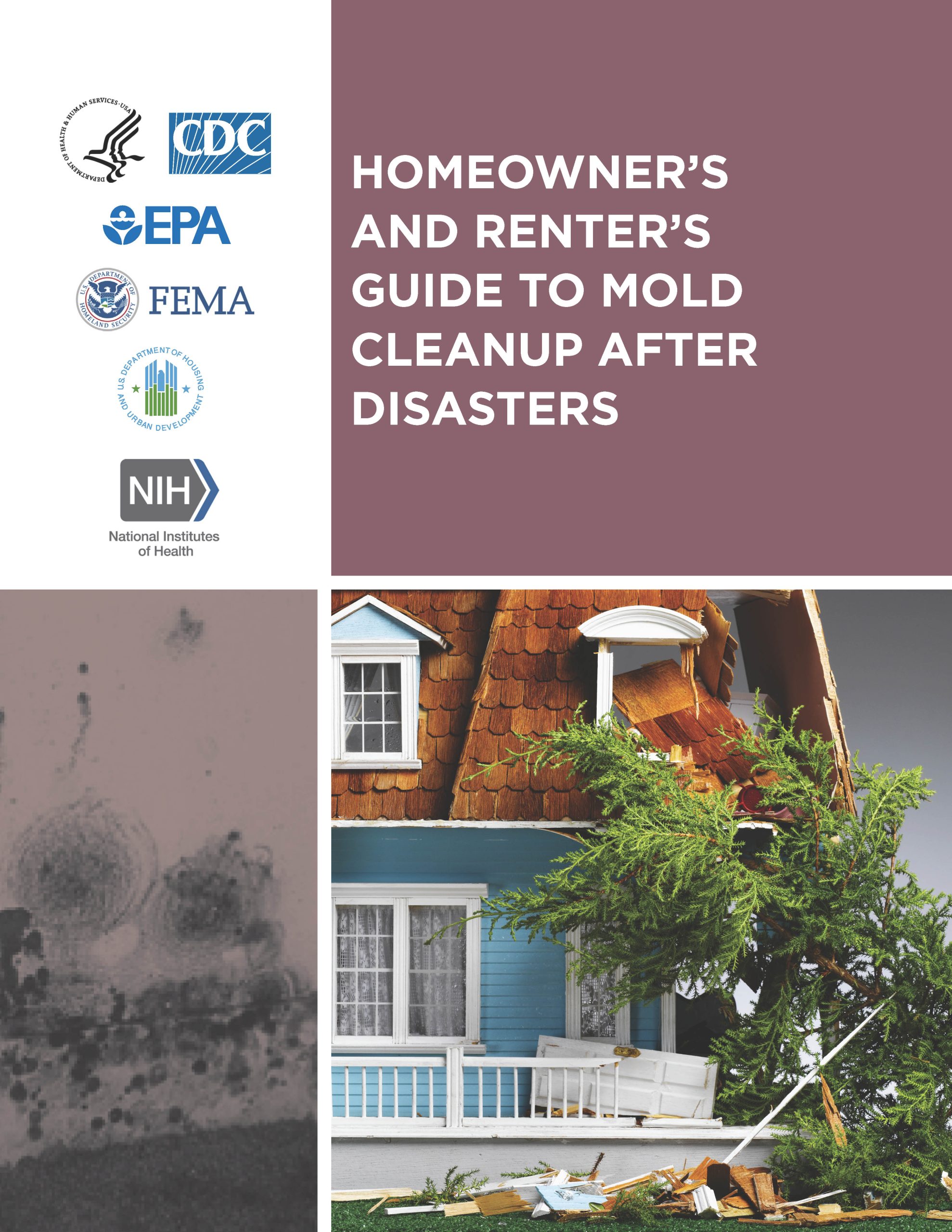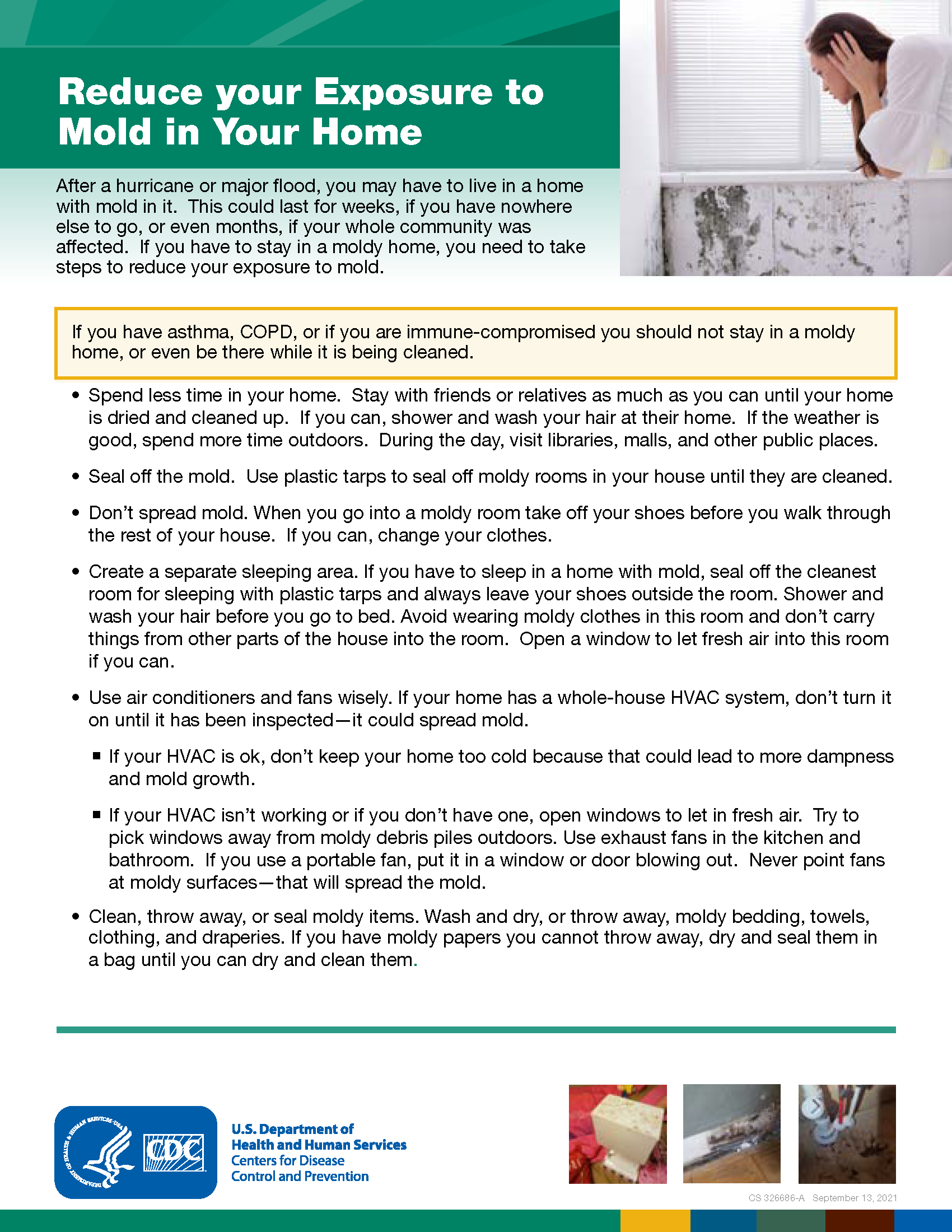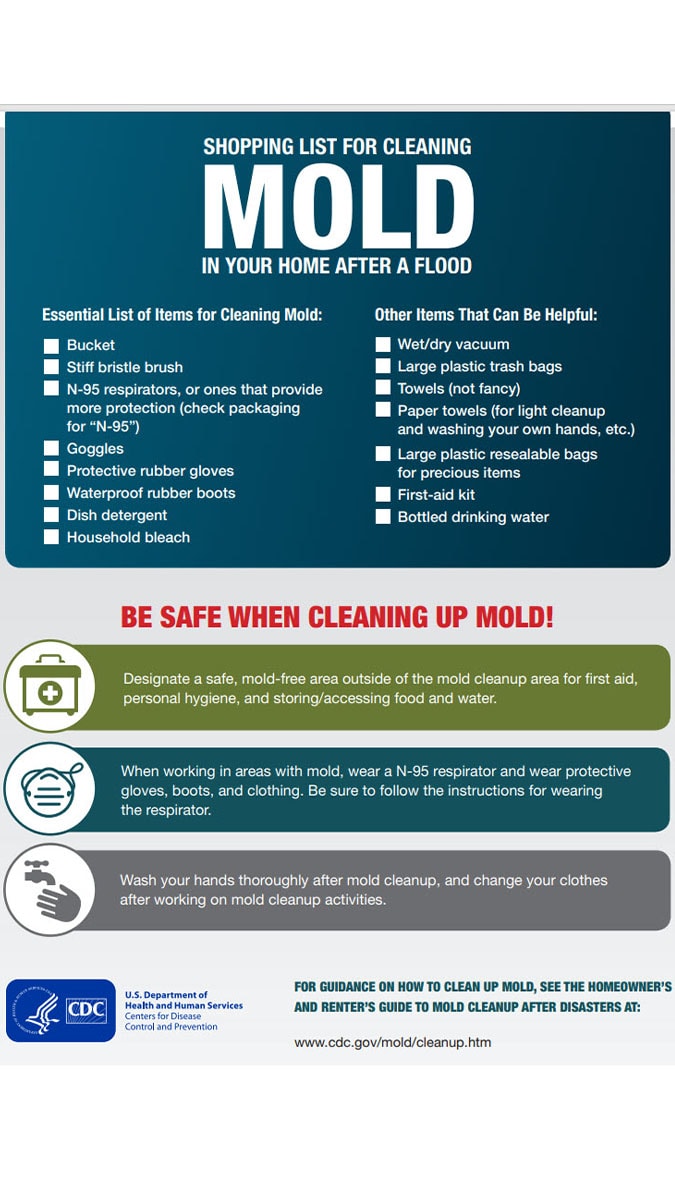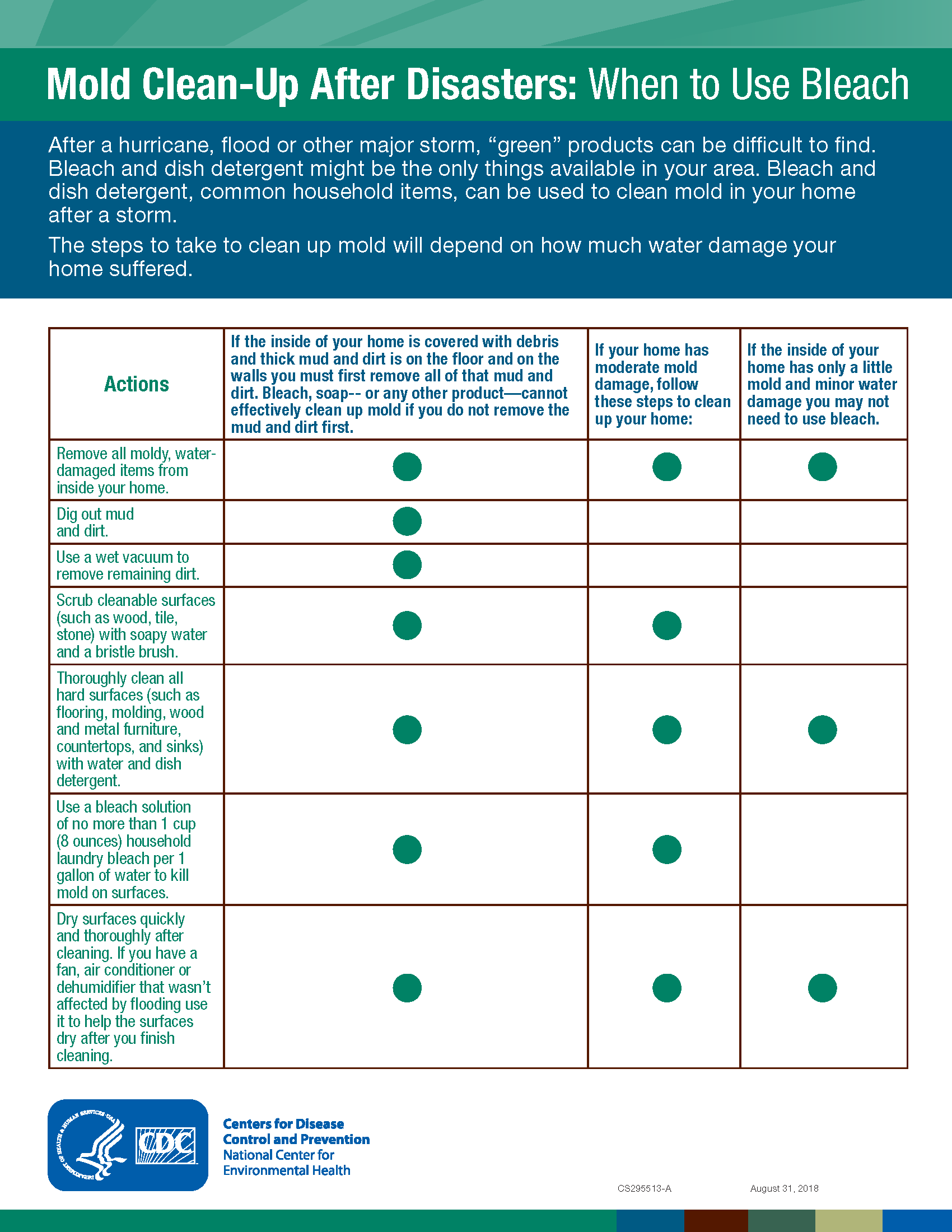Purpose
You can find fact sheets and other resources from CDC, EPA, and others, as well as publications, on mold-related issues.
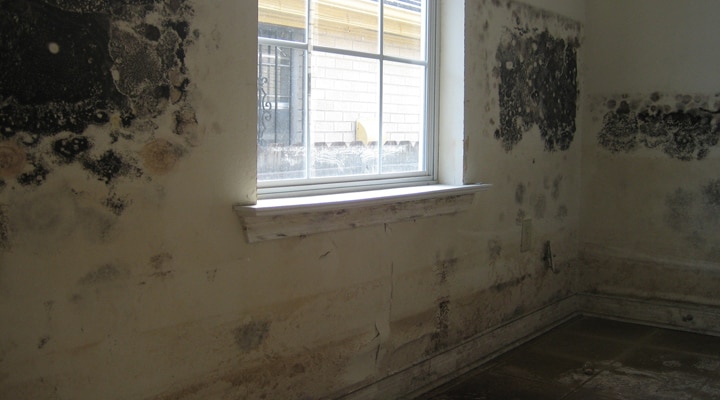
On mold remediation and cleanup
Homeowners and Renters Guide to Mold Cleanup After Disasters
Reducing Your Exposure to Mold
Shopping List for Cleaning Mold in Your Home After a Flood
What to Wear Before Entering a Home or Building with Mold Damage
From federal sources
EPA's mold website:
Frequently requested EPA resources:
Provides documents on mold from FEMA, whose mission is to reduce loss of life and property and to protect the nation’s critical infrastructure from hazards.
Provides information on Farmer’s Lung and other respiratory hazards related to exposure to mold spores while working in dusty fields, silos, and grain bins. Includes symptoms, treatment, and control procedures.
Provides information on Farmer’s Lung, an allergy caused by dust from moldy hay, straw and grain, including symptoms and methods of minimizing exposure.
Provides search results on Indoor Environmental Quality and Mold from NIOSHTIC, a searchable bibliographic database of occupational safety and health publications, documents, grant reports, and journal articles supported in whole or in part by the National Institute for Occupational Safety and Health. Click “Full View” to read article abstracts.
Provides information on indoor dampness and associated health risks.
Workplace Mold and Your Health
Provides information about respiratory and non-respiratory health problems in workers associated with mold and dampness.
Provides documents on mold from NIEHS, whose mission is to reduce the burden of human illness and dysfunction from environmental causes by understanding each of these elements and how they interrelate. Search on “mold” to see NIEHS’ list of mold-related documents.
Provides information in English and Spanish on molds, including cleanup, health aspects, organizations dealing with it, and other resources.
Provides recommendations on how to prevent mold growth and how to protect workers involved in the prevention and cleanup of mold.
Provides recommendations to owners, managers, and occupants on how to fix mold problems in buildings.
From nonfederal sources
Provides information on mold and allergies from AAFA, a non-profit patient organization dedicated to improving the quality of life for people with asthma and allergies and their caregivers, through education, advocacy, and research.
Provides information regarding health concerns associated with mold exposure in the home and advice on finding and removing mold contamination.
Provides common questions and answers about mold.
Provides information on health issues, assessment, remediation, and hazard communication.
Provides information on bioaerosol effects, sources, and control.
Provides information on Farmer’s Lung, a noninfectious allergic disease caused by inhaling dust from moldy hay, straw, or grain.
Review of scientific evidence on health problems associated with building moisture and biological agents.
Publications
Chew GL, Horner WE, Kennedy K, Grimes C, Barnes CS, Phipatanakul W, Larenas-Linnemann D, Miller JD, Environmental Allergens Workgroup. “Procedures to assist healthcare providers to determine when home assessments for potential mold exposure are warranted.” J Allergy Clin Immunol Pract 2016; 4:417-22. DOI: 10.1016/j.jaip.2016.01.013.
Chow NA, Toda M, Pennington AF, Chew GL et al. “Hurricane-Associated Mold Exposures Among Patients at Risk for Invasive Mold Infections After Hurricane Harvey — Houston, Texas, 2017.” MMWR 2019; 68:469–473.
Coombs KC, Chew GL, Schaffer C, Ryan PH, Brokamp C, Grinshpun SA, Adamkiewicz G, Chillrud S, Hedman C, Colton M, Ross J; Reponen T. “Indoor air quality in green-renovated vs. non-green low-income homes of children living in a temperate region of US (Ohio).” Science of the Total Environment 2016; 554-555, 178-85. DOI: 10.1016/j.scitotenv.2016.02.136.
Coombs K, Taft D, Ward D, Green BJ, Chew GL, Shamsaei B, Meller J, Indugula R, Reponen T. “Variability of indoor fungal microbiome of green and non-green low-income homes in Cincinnati, Ohio.” Science of the Total Environment 2018; 610-611: 212-218. DOI: 10.1016/j.scitotenv.2017.07.274.
Damon SA, Chew GL. “Mold Cleanup Practices Vary by Sociodemographic and Allergy Factors.” Journal of Environmental Health 2020.
Gold DR, Adamkiewicz G, Arshad SH, Celedon JC, Chapman MD, Chew GL, Cook DN, Custovic A, Gehring U, Gern JE, Johnson CC, Kennedy S, Koutrakis P, Leaderer B, Mitchell H, Litonjua AA, Mueller GA, O’Connor GT, Ownby D, Phipatanakul W, Persky V, Perzanowski MS, Ramsey CD, Salo PM, Schwaninger JM, Sordillo JE, Spira A, Suglia SF, Togias A, Zeldin DC, Matsui EC. “NIAID, NIEHS, NHLBI, and MCAN Workshop Report: The indoor environment and childhood asthma-implications for home environmental intervention in asthma prevention and management.” Journal of Allergy and Clinical Immunology 2017; 140(4): 933-949. DOI: 10.1016/j.jaci.2017.04.024.
Kawamoto M, Page E. “Notes from the Field: Use of Unvalidated Urine Mycotoxin Tests for the Clinical Diagnosis of Illness — United States, 2014.” MMWR 2015; 64(06): 157-158.
Major JL, Boese GW. “Cross Section of Legislative Approaches to Reducing Indoor Dampness and Mold.” J Public Health Management & Practice 2017; 23 (4): 388–395. DOI: 10.1097/PHH.0000000000000491.
Roberts JR, Newman N, McCurdy LE, Chang JS, Salas MA, Eskridge B, DeYbarrondo L, Sandel M, Mazur L, Karr CJ. “Integrating Environmental Management of Asthma into Pediatric Health Care: What Worked and What Still Needs Improvement?” Clinical Pediatrics 2016: (55)14: 1271-1278. DOI: 10.1177/0009922815621033.


